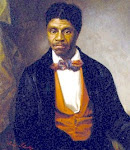“Deep River, my home is over Jordan. Deep River, Lord; I want to Pass over to Camp Ground.” - Slave Prayer on Marker Stone at Slave Cemetery on site of Peter Blow Plantation,
Oakwood College, Huntsville, AL
Oakwood College, Huntsville, AL
 In 1857, Roger B. Tawney in his 20th year as Chief Justice of the United States Supreme Court, took the bench with his fellow justices in the old Supreme Courtroom inside the U.S. Capitol Bldg. and began to read his ruling in the case of Dred Scott v. Sandford. It was only the second time in history (after Marbury v. Madison) that the Supreme Court ruled an act of Congress (in this case the Missouri Compromise) to be unconstitutional. But it wasn't that rare action that made the decision notorious – rather it was the extraordinary way in which the very embodiment of justice (“WE the PEOPLE…establish JUSTICE”)leaped beyond the scope of Scott’s claim to declare that a black man is not man and has no rights that a white man is bound to respect!
In 1857, Roger B. Tawney in his 20th year as Chief Justice of the United States Supreme Court, took the bench with his fellow justices in the old Supreme Courtroom inside the U.S. Capitol Bldg. and began to read his ruling in the case of Dred Scott v. Sandford. It was only the second time in history (after Marbury v. Madison) that the Supreme Court ruled an act of Congress (in this case the Missouri Compromise) to be unconstitutional. But it wasn't that rare action that made the decision notorious – rather it was the extraordinary way in which the very embodiment of justice (“WE the PEOPLE…establish JUSTICE”)leaped beyond the scope of Scott’s claim to declare that a black man is not man and has no rights that a white man is bound to respect!". . . We think they [people of African ancestry] are . . . not included, and were not intended to be included, under the word "citizens" in the Constitution, and can therefore claim none of the rights and privileges which that instrument provides for and secures to citizens of the United States. . . ." — Chief Justice Roger B. Taney, speaking for the majority
During the past 150 years, Dred Scott v. Sandford , has been unanimously criticized by historians, law professors and even supreme court justices as the “ghastly error” and likely the worst in the history of SCOTUS. (Why they even got the title wrong!) Justices have sometimes used it as a slur against a majority opinion. For example, Justice Scalia wrote that the majority opinion in Planned Parenthood v. Casey “was no more legitimate than Dred Scott.”
So why write a book about it? What was it’s significance? Are there lessons to be learned? What impact did it have on the history of the United States of America, on slavery and civil rights? Where are we 150 years later? My goal writing Am I Not a Man? The Dred Scott Story was to bring Dred and Harriett Scott to life and to propel them to the forefront of American History and Heroism and that after reading it, every one of you will think not just of the legal significance of “Dred Scott” but of Dred Scott, the man.

You’ll see that most of Dred’s life was spent on and around great rivers and small streams. In the words of Will Durrant, "Civilization is a stream with banks. The stream is sometimes filled with blood from people killing, stealing, shouting and doing the things historians usually record, while on the banks, unnoticed, people build homes, make love, raise children, sing songs, write poetry, and even whittle statues. The story of civilization is the story of what happened on the banks. Historians...ignore the banks for the river."
As an author of this work of historical fiction, I have celebrated the lives along the banks while documenting the journey upon and across the rivers that have divided this nation.
“The source of the American River is the pure, clear, dream of freedom, and justice and mercy; the lifeblood of a visionary embodiment of human hunger for a better life; the powerful current of this notion, this nation, indelibly carving its course into the landscape of the world.” - Kris Kristofferson, The Source, from the album “American River,” by Jonathan Elias


And a lyrical, masterful depiction it is.
ReplyDelete